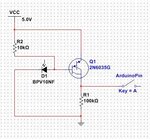boylesg
Advanced Member level 4

- Joined
- Jul 15, 2012
- Messages
- 1,023
- Helped
- 5
- Reputation
- 10
- Reaction score
- 6
- Trophy points
- 1,318
- Location
- Epping, Victoria, Australia
- Activity points
- 11,697
This is a really basic circuit but I am having trouble with it none the less:
Q1 is actually BC517 on my real circuit and D1 is a SHF309FA-3/4 or alternatively a photo diode I got from ebay but am unsure as to its identity.
Regardless I am getting a roughly 1V differential on the base of the BC517 when I shine a TV remove into the photo diode.
But I am only getting a milli-volt differential on the emitter of the BC517. So why is the darlington not amplifying the current and the voltage?
How do I get a 2-3V differential out of the photo-diode?
Q1 is actually BC517 on my real circuit and D1 is a SHF309FA-3/4 or alternatively a photo diode I got from ebay but am unsure as to its identity.
Regardless I am getting a roughly 1V differential on the base of the BC517 when I shine a TV remove into the photo diode.
But I am only getting a milli-volt differential on the emitter of the BC517. So why is the darlington not amplifying the current and the voltage?
How do I get a 2-3V differential out of the photo-diode?


